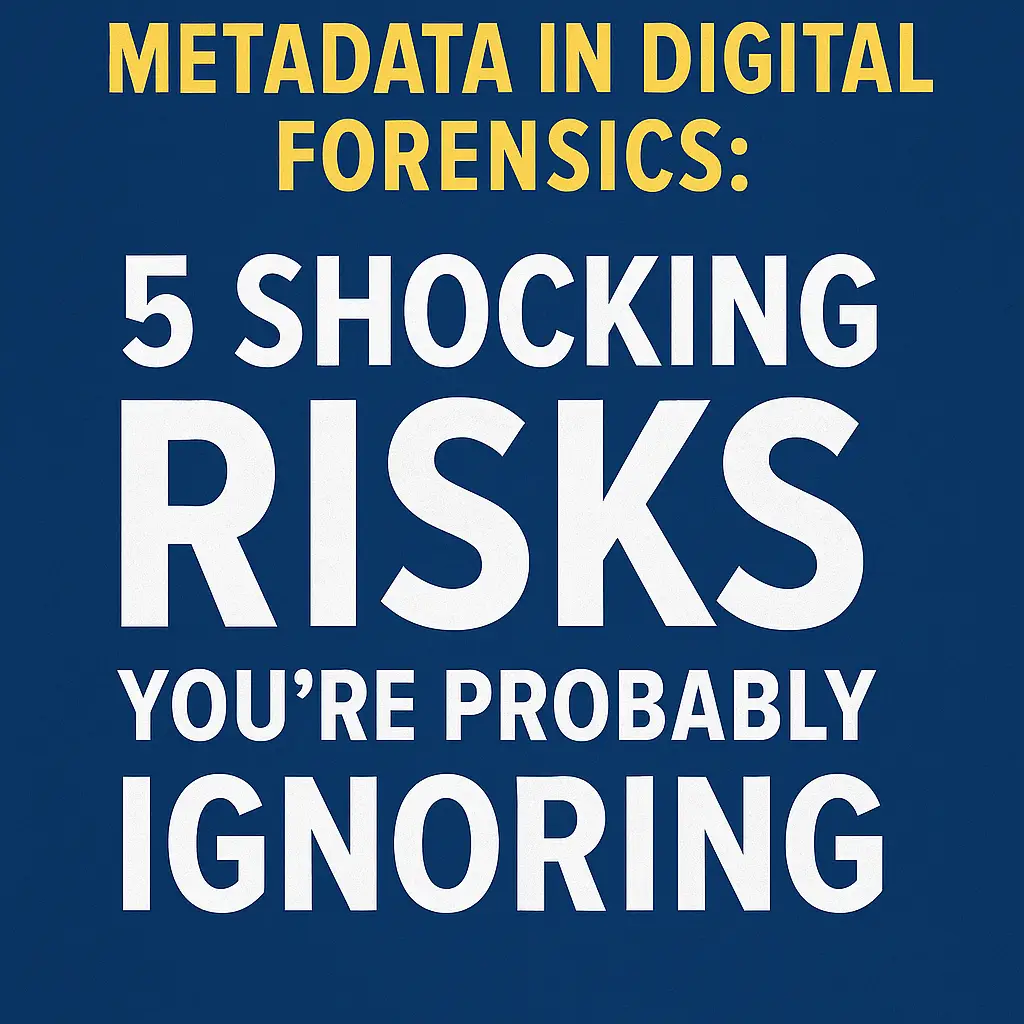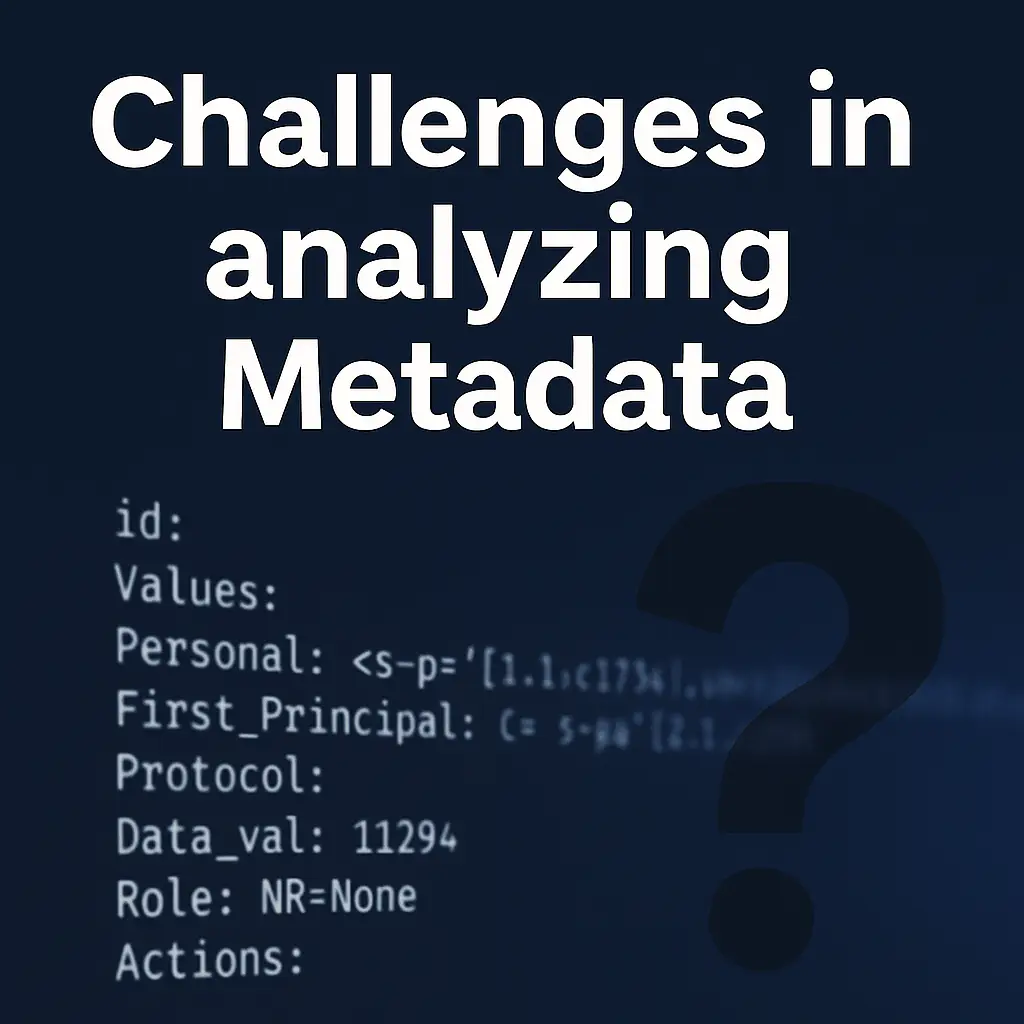
What is Metadata in Digital Forensics?
In digital forensics, metadata refers to the hidden information that is embedded in digital files and, rather than the content that is visible, gives important details about the file’s features and history. Metadata is simply “data about data.” It contains information on a file’s creation date, creator, modification date, and usage or access over time.
Metadata is an essential source of evidence in the field of digital forensics. It enables investigators to reconstruct events and find digital footprints that are not visible from the text alone. Metadata can provide important information that helps create timelines, confirm authenticity, and identify persons engaged in digital activities, regardless of the type of digital artifact—a document, email, photo, or anything else.
Because metadata can disclose usage patterns, file origin, and even attempts to alter or conceal information, digital forensics specialists rely largely on it. Because of this, metadata is a crucial component of investigations into anything from corporate espionage and criminality to legal disputes and regulatory compliance.
For a basic introduction to the field, see our Introduction to Digital Forensics if you’re new to it.
Types of Metadata Used in Digital Forensics
Understanding the different types of metadata is essential for appreciating its role in digital forensics:1.
1.Metadata of the File System
Operating systems automatically create this kind of metadata, which contains details like the date the file was created, the date it was last edited, the date it was last accessed, its size, and its permissions. It aids forensic specialists in comprehending the creation date and device handling of a file.
2. Metadata for Documents
Author names, revision histories, editing timestamps, and comments are examples of document metadata that can be embedded within files. For instance, extensive editing logs that can show who made changes and when are frequently stored in Microsoft Office files.
3. Metadata for Email
Sender and recipient addresses, timestamps, route details, and server logs are examples of email metadata. Email header analysis can reveal communication routes, illegal servers, and spoofing attempts—all of which are crucial information for phishing or fraud investigations.
4. Metadata Embedded
This includes secret information that users or devices have added, including hidden notes, camera model details, or geolocation tags in images or videos. For example, EXIF information in digital photos can help locate a suspect at a crime scene by providing timestamps and GPS locations..
5. Metadata for Networks
IP addresses, connection logs, and routing data are examples of metadata used in network forensics that aid in determining the source and trajectory of digital communications.
A comprehensive perspective of digital evidence can be obtained by combining the distinct layers of information provided by each type of metadata.
How Digital Forensics Investigations Are Assisted by Metadata

In digital forensics investigations, metadata is essential for a number of reasons:
1.Rebuilding Timelines
Investigators can reconstruct the timeline by examining timestamps in metadata. Knowing what happened, when it happened, and in what order is essential. For instance, metadata can help generate a timeline of events by displaying the creation, modification, and access dates of a document.
2.Verifying the Authenticity of the Evidence
Inconsistencies that point to forgery or tampering can be found in metadata. A document’s credibility may be weakened, for instance, if it states that it was generated before a specific date yet the metadata indicates a later creation timestamp.
3.Monitoring User Behavior
User-specific information, like device identifiers or usernames, is frequently found in metadata. In situations involving insider threats or unauthorized access, this aids in connecting data and actions to certain people, which is crucial.
4.Finding Equipment or People
Suspects may be placed at particular areas using geolocation metadata included in images or mobile files. This kind of evidence can support surveillance footage or witness accounts.
Aiding Corporate and Legal Investigations
Metadata offers unbiased, verifiable proof that might be utilized in legal proceedings or business inquiries. It assists in identifying fraudulent activity, tracking data exfiltration, and demonstrating the validity of documents.
The Difficulties of Metadata Analysis

Despite its benefits, metadata analysis has a number of drawbacks.
1.Privacy Issues
Strict adherence to ethical standards and privacy rules is necessary when handling metadata, particularly when sensitive or personal data is at stake.
2.Obfuscation of Metadata and Encryption
To avoid detection, criminals may purposefully change metadata or encrypt it. Such info requires sophisticated forensic techniques and knowledge to recover or understand.
3.Data Volume and Complexity
Analyzing enormous volumes of data with intricate metadata structures is a common step in investigations. Expert analysts and sophisticated software are needed to manage and understand this data effectively.
4.Metadata Flexibility
Regular file actions, such as copying or format conversion, might inadvertently change or erase metadata. Careful handling and appropriate forensic processes are necessary to maintain metadata integrity.
Applications of Metadata in Digital Forensics in the Real World
In many studies, metadata analysis has proved essential:
1.Legal Actions
Courts use metadata to confirm the timeliness and legitimacy of documents. For example, metadata can indicate whether a document was modified after the fact or backdated, which could affect the outcome of a lawsuit.
2.Corporate Research
Businesses look into policy infractions, data breaches, and intellectual property theft using metadata. Unauthorized file transfers or uploads can be detected with the use of metadata timestamps and access logs.
3.Criminal Inquiries
Law enforcement agencies use metadata to reconstruct crime scenes and identify suspects. For example, email metadata can expose phishing schemes, while photo geotags can place suspects at crime scenes.
4.High-Profile Cases
The Enron scandal is a notable example where metadata played a crucial role. Email metadata and document version histories helped uncover deliberate accounting fraud and internal communications that misled investors. This evidence led to convictions and reforms in corporate regulations such as the Sarbanes-Oxley Act6.
Best Practices for Handling Metadata in Investigations
Investigators should adhere to these best practices to make sure metadata continues to be a trustworthy source of evidence:
1.Maintain the Integrity of Metadata
To stop metadata tampering, use write-blockers to create forensic pictures of devices. Do not alter or open files prior to imaging.
2.Make Use of Expert Forensic Equipment
Use specialized software made to precisely extract and analyze metadata. These technologies can provide reports that are legally defendable and handle complicated metadata formats.
3.Preserve the Custody Chain
To maintain the chain of custody, record each stage of the evidence collecting and analysis process. This guarantees that metadata evidence is reliable and admissible in court.
4.Integrate Metadata with Additional Proof
For a thorough inquiry, metadata should be examined in addition to system logs, network data, and tangible evidence.
5.Remain Current with Technical and Legal Standards
The field of digital forensics is constantly changing. Investigators should stay up to date on developments in forensic tools, privacy laws, and metadata standards.
Conclusion
In digital forensics, metadata is the hidden information that tells the invisible tale of digital files. Investigators are able to recreate timelines, evaluate evidence, and identify accountable individuals thanks to the crucial information it gives regarding file creation, modification, user activity, and location.
Despite obstacles like data complexity and privacy issues, metadata is nevertheless essential to contemporary digital investigations. It is essential in criminal, business, and legal situations because of its capacity to reveal hidden facts.




Leave a Reply